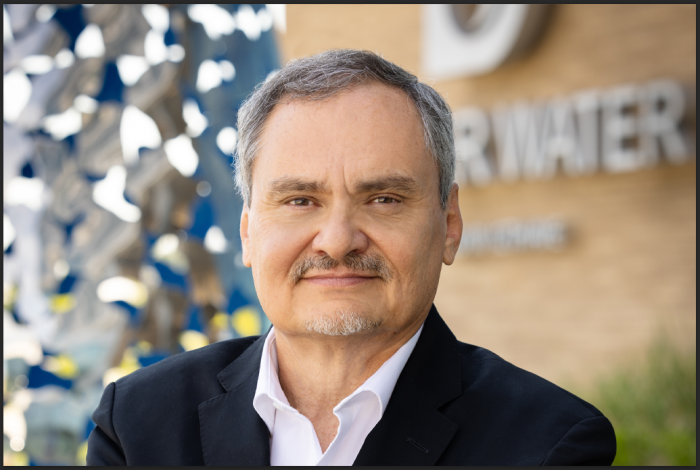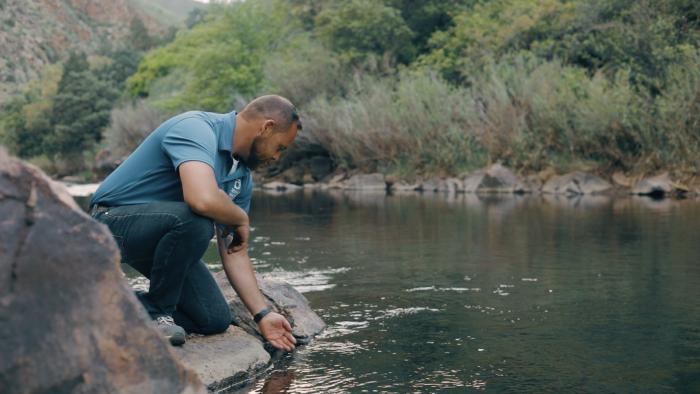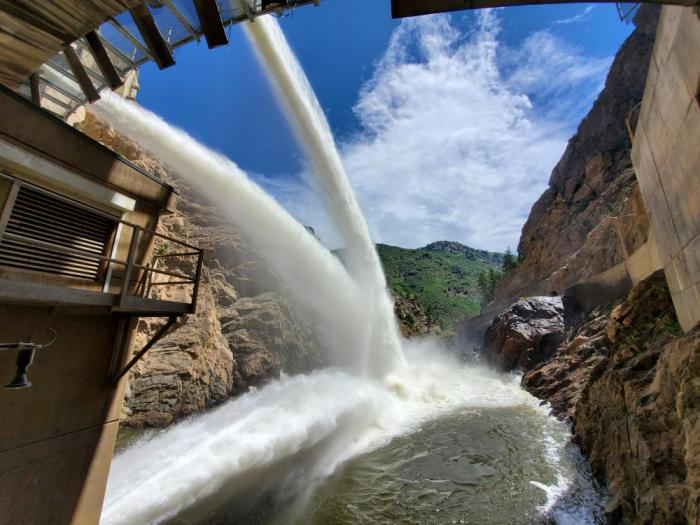Seeing Denver Water’s history through its people
In the office of Denver Water CEO/Manager Alan Salazar, old black and white photos of workers, pipes and dams from the archives hang next to beauty shots of snow-capped peaks and mist-shrouded reservoirs.
Salazar, who in August 2023 became the 16th person to lead Colorado’s oldest and largest water provider since city voters created the utility in 1918, pulls another black and white picture from the pile on the dark wood table in his office. This one shows a man — one of Salazar’s predecessors — wading through water up to the ankles of his knee-high rubber boots.
“I love history, and I asked our archivist for pictures of Denver Water with people because it’s the individual history that comes through. Denver Water’s history isn’t just about the infrastructure — the dams and the pipes — it’s about human hands, human ingenuity and interactions … and yes, human struggles,” Salazar said.
“The history of this part of the country is very much written by the history of Denver Water. There wouldn’t be a Denver without Denver Water. These pictures remind me that what we have today is due to the foresight of past leaders, and we have a responsibility to do what they did in terms of planning for the future. We also have a responsibility to be good stewards of our natural resources,” Salazar said.
A few months into his tenure leading Denver Water, Salazar talked about his early impressions of the utility, the challenges it faces and what he wants customers — and employees — to know.
What do you want customers to know?
I try to remind people that we serve about 25% of Colorado’s population using less than 2% of the water used in the state. That’s amazing, and people are surprised by that. I was surprised by that; I didn’t really know that before I came here.
I think people assume we use far more of the water in the state and they have no idea how committed this organization has been to efficiency and conservation.
So, I keep repeating that fact about how little water we actually use and that we’re serving more people and being good stewards of the water, and that we’ll continue that work.
When you started at Denver Water, you set a goal of meeting each of the 1,000-plus employees. Why did you choose that goal and what do you want employees to know?
I set it as a goal because, for one, it’s a tool to discipline myself to meet more and more of our employees and learn and understand what they do.
Secondly, if I was an employee with a new person coming in to lead that organization, I’d want that person to know how I was contributing to the organization and understand how it all fits together.
Third, my experience at the city of Denver (where Salazar was chief of staff to former Mayor Michael Hancock for nearly seven years), is that I learned a lot from the career service employees who had been at the city for a long time.
My job is not to just cheerlead, but to detect if there are challenges or difficulties for employees, and my overall impressions from the employees are overwhelmingly positive.
I want employees to know how thankful I am that they have welcomed me and that I have appreciated their honesty. And more than anything, I’ve appreciated the opportunity to work with people who — across the board — have an obvious commitment and intensity about excellence in their work.
People are really proud of the fact that they’re delivering something that is life-sustaining for our community.
Denver Water historically has been led by engineers or water lawyers. You’re a lawyer, but you’re not an engineer. Your career, more than three decades, has included working for two Colorado governors, two of the state’s U.S. senators and a U.S. representative and Denver’s most-recent mayor.
What experience do you have with water issues, and what does your background bring to Denver Water?
I’ve been very clear with everyone right up front: I’m not a water lawyer nor am I a civil engineer. My experience with water comes from water policy, water politics and water regulations, through the lens of someone working in federal, state and local government.
So, I’m very familiar with the importance of water, and I think you can’t be involved in planning for the future or dealing with the issues affecting communities unless you have an understanding of the way water has driven our development.
I worked with Gov. John Hickenlooper on Colorado’s first Water Plan (published in 2015). I’ve helped elected officials dealing with water legislation and planning. And when Denver Water’s board brought me on, they understood that this is new territory; that I bring a different set of eyes and experience.
The story of water in Colorado is a story of intense politics, and I know a thing or two about politics. There is value in an awareness of and experience with the local, state and federal levels of government, all the elements of government that touch what we do here at Denver Water and can make our jobs harder or easier.
And I bring to Denver Water my experience at the city of Denver, being responsible for a large, complicated organization that has a lot of people working in different areas all trying to do the right thing.
And going through what we all went through together in the uncharted territory that was the pandemic gave me a sense of urgency around recovery — not just recovery of downtown, but also for the whole Denver metro region. I’m aware of the fact that Denver Water is more than a utility — that’s our primary function — but we’re also stewards.
What challenges do you see ahead for yourself as CEO, and for Denver Water in general?
I see Denver Water as an “anchor institution,” an entity with an elevated public purpose. There’s a lot of cynicism around the belief that things are broken, that the world is in a bad place, that the media, business, politics and trusted institutions are broken. But people also tell me “I love Denver Water.”
We deliver water — that’s fundamentally what we do and we do it well. We have to do it well. That is our core business. But I can see that there are also other tables that Denver Water can sit at, bring value to, and help the wider post-COVID recovery that municipalities are experiencing.
As an example, Denver Mayor Mike Johnston is setting up microvillages as a way of handling homelessness — and whether you agree or disagree with that strategy isn’t my point. The point is that Denver Water is playing its role in helping to address the issue by providing a safe water supply to these locations. (The city will pay for water used at the locations.) It’s a small thing, but it’s an essential thing. And it shows that we are a reliable and compassionate partner.
Take density and future commercial and residential development in our community. It’s probably the wave of the future and I can’t think of an organization that is better at looking ahead 50-100 years than Denver Water.
The state has a big challenge with the Colorado River, and we obviously play a role with that, as about 50% of the water we use comes from the Colorado River. There are also issues around the effects of climate change, artificial intelligence impacts on the workforce and big changes with transit and energy. Water is an integral part of these challenges.
Join the people providing water to their community, at denverwater.org/Careers.
When I say Denver Water is an “anchor institution,” I think of the collective expertise of the people who work at Denver Water who come from all walks of life, working at an organization that people trust, at a time of turmoil and change. Denver Water can help solve problems and navigate these challenges.
In my office I have a sculpture, a bust, of President John F. Kennedy because it reminds me of a quote from him, a quote about how the ancient Greek definition of happiness “was the full use of your powers along lines of excellence.”
I think that’s really important, and I’ve found it here at Denver Water, in the people who work here and their commitment to excellence.
A video tour with Denver Water employees, via CEO/Manager Alan Salazar:





